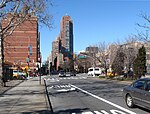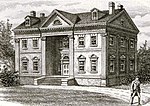Congregation Ohab Zedek
Hungarian-American culture in New York CityHungarian-Jewish culture in New York (state)Modern Orthodox synagogues in the United StatesMoorish Revival architecture in New York CityMoorish Revival synagogues ... and 6 more
Orthodox synagogues in New York CityProperties of religious function on the National Register of Historic Places in ManhattanReligious organizations established in 1873Synagogues completed in 1926Synagogues in ManhattanUpper West Side
Ohab Zedek, sometimes abbreviated as OZ, is an Orthodox Jewish synagogue in Manhattan, New York City noted for its lively, youthful congregation. Founded in 1873, it moved to its current location on West 95th Street in 1926. The current clergy are: Rabbi Allen Schwartz, Senior Rabbi and Rabbi Jack Varon, assistant Rabbi.
Excerpt from the Wikipedia article Congregation Ohab Zedek (License: CC BY-SA 3.0, Authors).Congregation Ohab Zedek
West 95th Street, New York Manhattan
Geographical coordinates (GPS) Address External links Nearby Places Show on map
Geographical coordinates (GPS)
| Latitude | Longitude |
|---|---|
| N 40.792411111111 ° | E -73.968994444444 ° |
Address
Ohab Zedek
West 95th Street 112
10025 New York, Manhattan
New York, United States
Open on Google Maps









